|
 WELL LOGGING BASICS
WELL LOGGING BASICS
Well logging is the process of recording various physical, chemical,
electrical, or other properties of the rock/fluid mixtures penetrated
by drilling a borehole into the earth's cruste. A log is a record
of a voyage, similar to a ship's log or a travelog. In this case, the ship is
a measuring instrument of some kind, and the trip is taken into
and out of the wellbore.
In
its most usual form, an oil well log is a record displayed on
a graph with the measured physical property of the rock on one
axis and depth (distance from a near-surface reference) on the other axis.
More than one property may be displayed on the same graph.
Well
logs are recorded in nearly all oil and gas wells and in many
mineral and geothermal exploration and development wells. Although
useful in evaluating water wells, few are run for this purpose.
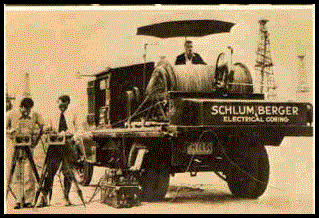
It was hot and breezy in California in 1932

The traditional well log is a record of various measurements of
the physical properties of rocks recorded versus depth (left side of
illustration). Each wiggly line is a log curve, representing a
particular roc property. More recently, imaging logs have appeared
in which colour and position versus depth are used to display data
in more intuitive formats (right half of illustration).
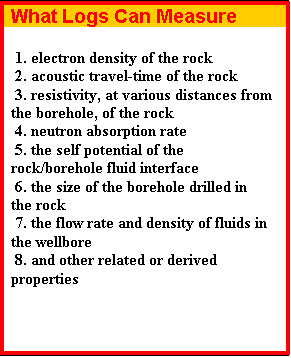 None
of the logs actually measure the physical properties that are
of most interest to us, such as how much oil or gas is in the
ground, or how much is being produced. Such important knowledge
can only be derived, from the measured properties listed in the
box on the left
(and others), using a number of assumptions which, if true, will
give reasonable estimates of hydrocarbon or mineral resources. None
of the logs actually measure the physical properties that are
of most interest to us, such as how much oil or gas is in the
ground, or how much is being produced. Such important knowledge
can only be derived, from the measured properties listed in the
box on the left
(and others), using a number of assumptions which, if true, will
give reasonable estimates of hydrocarbon or mineral resources.
Thus,
analysis of log and related laboratory data is required. The art and science of log analysis
is mainly directed at reducing a large volume of data to more
manageable results, and reducing the possible error in the assumptions
and in the results based on them. When log analysis is combined
with other physical measurements on the rocks, such as core analysis
or petrographic data, the work is called petrophysics or petrophysical
analysis. The results of the analysis are called petrophysical
properties or mappable reservoir properties. The petrophysical
analysis is said to be “calibrated” when the porosity,
fluid saturation, and permeability results compare favourably
with core analysis data. Further confirmation of petrophysical
properties is obtained by production tests of the reservoir intervals.
The
use of well logs for evaluating mineral deposits other than oil
and gas, such as coal, potash, uranium, and hard rock sequences
has been practiced since the early 1930’s and is widespread
today. Although the vast majority of logs are run to evaluate
oil and gas wells, an increased number are being run for
other purposes, including evaluation of geothermal energy and
ground water. A large portion of this Handbook
 TYPES OF LOGS
TYPES OF LOGS
Logs run on wireline into a hole which has just been drilled, and before it
is cased, are called open-hole logs. Logs run after the well is
cased are called cased-hole logs. Open hole logs are mainly used
to determine the petrophysical properties of the rocks. Some cased
hole logs are used for the same purpose. Others are used to assess
the integrity of the well completion; others are used to assess
fluid flow into the well.
Logs often make several measurements simultaneously and several
logging tools can be connected together to operate as a single
string of tools. The combinations have gained there own cryptic
names.
The terminology stems from how many individual
physical logging tools could be assembled and run in one pass into
the wellbore. As tools got smaller, you could fit more of them in
the derrick – took a lot of re-engineering to get all the signals to
pass thru all the tools. The terms "triple-combo" and "quad-combo"
are used to describe two specific tool string combinations in common
use today:
Triple-combo = resistivity + density + neutron
tools.
Quad-combo = resistivity + sonic + density +
neutron tools.
The gamma ray log is always included but doesn’t add to the tool
count.
A standard triple-combo is resistivity curves (with GR or SP or
both) plus density – neutron curves (with GR, caliper, density
correction, and PEF. Density + neutron counts as 2 of the 3 tools.
A
quad-combo adds a sonic log to the above tool string. This may
include only compressional sonic or both compressional plus shear
sonic. There may be more than one GR and caliper depending on the
era of the logs.
Some
combos can have spectral GR, which adds potassium, thorium, and
uranium curves.
Other
types of logs require no cable, such as a mud log which may record
up to 5 or 10 properties of the drilling fluid, or a drilling
log which records the rate of penetration and other functions
of the drilling process.
The
geology log, often called the stratigraphic log, strat log, or
sample description log, is a record of the rock samples retrieved
from the drilling mud, and is one of the primary sources of rock
and fluid descriptions for the well. It consists of a verbal description
of the rock type as well as qualitative or interpretive data concerning
evidence of the fluid content of the rock. These are all useful
logs and are used in any analysis of a well, if they are available.
Most
logs can now be recorded while drilling is going on or while
tripping the drill pipe. This is called
measurements while drilling (MWD) or logging while drilling (LWD).
Open-hole logs require that the drill string be removed from the
well bore before the logging tools can be lowered into the hole.
MWD does not have this need, so measurements are available continuously
as drilling proceeds.
A
composite log is made up of measurements and interpretations from
many sources of data. It is usually made up in the office in a
standard format (for the company or agency who owns the well).
Since it compresses a great deal of data onto one log, it is often
one of the most used items in the well file.
Most
open and cased-hole logs are recorded continuously as the tools
are pulled out of the hole. A few logs, however, may only be recorded
when the tool is stationary in the hole, such as the gravity meter
survey. Such logs are called station-by-station logs as opposed
to continuous logs. Some early station-by-station logs, by virtue
of significant improvements in measuring and recording techniques,
have become continuous logs. The first electrical log run in 1927
was station-by-station, but soon after, electrical logs were run
as continuous logs.
Most open hole logs are run in a conductive mud system. Muds
with relatively high resistivity are called fresh muds, and
those with low resistivity are called salt muds. Salt muds may
be salted on purpose to reduce erosion in shales or solution of
salt beds while drilling through them.
Oil-base muds are non-conductive and cause a few
problems, but not many are serious. You cannot run SP, microlog,
microlaterolog, or laterlog because they need conductive mud.
Dipmeter and Formation Micro Scanners need scratcher pads but
otherwise operate normally. Sonic, density, neutron, gamma ray,
NMR, caliper, induction logs all work normally.
Logs are used for a variety of purposes depending on the nature
of the data gathered. Correlation from well to well is the oldest
and probably the most common use of logs. It allows the subsurface
geologist to map formation depths and thicknesses and then to
identify conditions that could trap hydrocarbons.
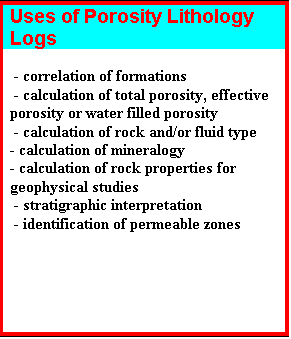 Correlation
is usually based on the shapes of the recorded curves versus depth.
Correlation in complex geologic areas may be difficult or impossible,
and in any event requires corroboration from actual rock samples
for the initial correlations in an area. After the curve shape
patterns are recognized, they can often be used in subsequent
wells without relying too heavily on rock sample data. Correlation
is usually based on the shapes of the recorded curves versus depth.
Correlation in complex geologic areas may be difficult or impossible,
and in any event requires corroboration from actual rock samples
for the initial correlations in an area. After the curve shape
patterns are recognized, they can often be used in subsequent
wells without relying too heavily on rock sample data.
Identification
of the lithology of the rock sequence is another important use
of logs. A log shows many variations from top to bottom. Each
wiggle has significance, but it can be related to the rocks being
logged only by comparing the log with actual rock samples or a
core from the well. After acquiring experience in an area it is
possible for a log analyst to make an educated guess as to lithology
by looking at the log. Modern analytical methods permit more accurate
lithology identification, but this requires charts or mathematical
solutions in addition to the curve shapes.
One
of the important uses of logs today is the determination of rock
porosity. This measurement is significant because it tells how
much storage space a rock has for fluids. No log actually measures
porosity directly, but many analytical methods are available to
help estimate this important property.
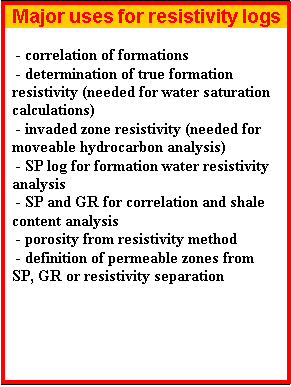 Another
of the routine uses of logs is the determination of the water,
oil, or gas saturation in the rock pores. When the porosity, oil
or gas saturation, the thickness and extent of the reservoir are
known, then it is possible to tell how much hydrocarbon is in
place in the reservoir. Again, no log actually measures the fluid
saturation directly, so analysis of indirect measurements is required.
The logs most often run for the above purposes are resistivity,
sonic travel time, density, neutron, gamma ray and spontaneous
potential logs. Another
of the routine uses of logs is the determination of the water,
oil, or gas saturation in the rock pores. When the porosity, oil
or gas saturation, the thickness and extent of the reservoir are
known, then it is possible to tell how much hydrocarbon is in
place in the reservoir. Again, no log actually measures the fluid
saturation directly, so analysis of indirect measurements is required.
The logs most often run for the above purposes are resistivity,
sonic travel time, density, neutron, gamma ray and spontaneous
potential logs.
One
of the older, but very useful, surveys is the caliper log. In
open hole logging, it is used to determine hole volume and aids
the engineer in designing a cementing program. It also indicates
mud cake build-up and hole wash-out. Both of these indications
are of interest to the log analyst when he considers the other
logs. In cased hole work the caliper is often used to find casing
damage and separated casing.
A
more recent development in logging is fracture-finding. It is
important because fractures will often produce large quantities
of fluid even though the rock the fractures are in would not otherwise
produce commercially. Many open-hole logs have some artifacts
caused by fractures, but the formation micro-scanner and borehole
televiewer are the most useful.
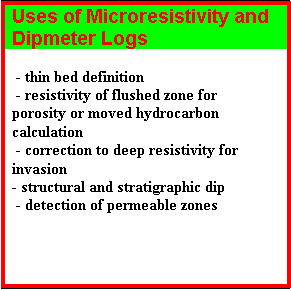 When
it is time to perforate the casing to allow fluid to flow into
the well, there may be some doubt about how well the perforator
depths match the log depths. To overcome this uncertainty, a casing
collar gamma ray log is often run. This log is correlated to the
open-hole log. Even though the actual depths may not agree, the
zone of interest on the open hole logs is related to the collar
log depth. Then the perforating gun is positioned in relation
to the collars in the casing and perforating accuracy is assured. When
it is time to perforate the casing to allow fluid to flow into
the well, there may be some doubt about how well the perforator
depths match the log depths. To overcome this uncertainty, a casing
collar gamma ray log is often run. This log is correlated to the
open-hole log. Even though the actual depths may not agree, the
zone of interest on the open hole logs is related to the collar
log depth. Then the perforating gun is positioned in relation
to the collars in the casing and perforating accuracy is assured.
The
measurement of fluid flow in and near the wellbore is often of
vital importance. Such measurements can indicate channels behind
casing, casing leaks, packer leaks, tubing leaks, water influx
problems, cross flow from one reservoir to another, and other
production problems.
Another
common use for this type of measurement is the determination of
water input profiles in water injection wells. A thief zone may
take most of the water and leave the rest of the reservoir unflooded.
Surveys of this type point out the type of remedial action that
is necessary to establish a more desirable water input distribution.
Generally
it is not advisable to complete a well in a zone that has poor
bond between cement and casing without first squeezing in more
cement to seal the casing to the rock formation. A cement bond
or cement evaluation log is used to identify this problem.
The
temperature log is commonly used to indicate the top of cement
behind a newly cemented string of casing. The setting cement liberates
heat and warms up the well bore, which is thus recognizable on
a temperature log of the well.
Another
use for the temperature log is the location of points of fluid
entry in a well bore or of fluid flow behind casing. As the fluid
enters the well it expands and cools creating abnormally low temperature
in the well at the point of entry. Acoustic noise logs also find
flow entry and flow behind pipe by the noise caused by the flowing
fluid.
The
most significant change in the use of logs, in recent years, is
production monitoring. The thermal decay time log (often called
a pulsed neutron log) allows for the interpretation of porosity
and fluid saturation behind casing. The fluid saturation will
change over time as a reservoir is depleted by production, and
the changes may be monitored by logging at regular intervals,
say once a year. If the production pattern is not as predicted,
remedial action may be possible. The log is also used to provide
porosity and fluid saturation data in wells which are not, or
could not, be logged in the more conventional open-hole manner.
A
large suite of logging instruments is available to evaluate fluid
type, fluid flow, and mechanical conditions in producing or injecting
wells, in addition to those already mentioned. These are generically
called production logs and are usually run in cased holes, but
some are also effective in open hole or "bare-foot"
completions. Production log analysis is not described in this
book as excellent treatments are available elsewhere.
The
same logs that are used to evaluate porosity and water saturation
in oil and gas wells are also used to evaluate other resources
such as ground water, coal, potash, salt, uranium, oil shale,
gypsum, sulfur, geothermal energy, tar sands, and hard rock minerals.
Logs are also used to explore the earth's surface in general,
such as in the Deep Sea Drilling Program which has helped to document
the theory of plate tectonics, sea floor spreading, and continental
drift.
 LOG SCALES and LAYOUT
LOG SCALES and LAYOUT
Logs
can be run on a number of vertical (depth) scales and quite a
variety of horizontal (curve value) scales.
Common
Logging Scales
| |
English |
Metric |
|
Often
Called |
Terminology |
Terminology |
|
Detail
scale or |
|
|
|
large
scale |
5"
= 100 ft |
1:240 1:200 is also very common |
|
Correlation
scale or |
2"
= 100 ft |
1:600
1:500 is also very common |
|
small
scale |
1"
= 100 ft |
1:1200
1:1000 is also very common |
|
Super
detail scale |
10"
= 100 ft |
1:120
1:100 is also very common |
|
* |
25"
= 100 ft |
1:48
1:50 is also very common |
|
Dipmeter
scale |
60"
= 100 ft |
1:20 |
| |
|
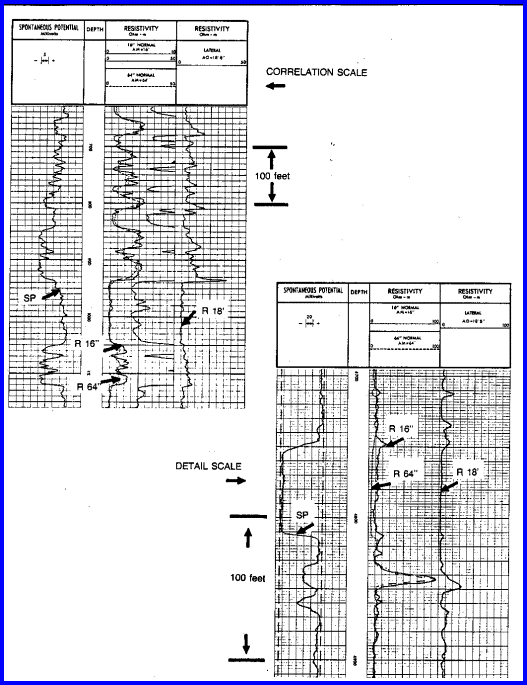
Correlation and Detail Scale Logs
The
spacing between depth grid lines is 10 feet or 5 meters for correlation
scales and 2 feet or 1 meter for other scales. Heavier grid lines
appear every 10 feet (5 meters) and every 50 feet (25 meters).
(Meters)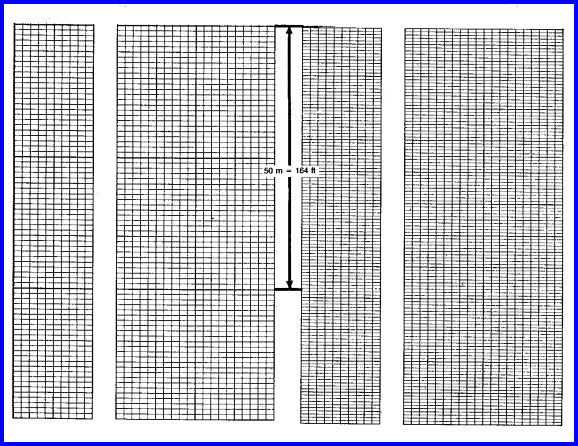
Metric and English (USA) Log Grids – Detail
Scale
Logs
are presented in the field in a three track presentation. The
pair of tracks 2 and 3 is often called track 4, which is used
to record curves with a large range in values.
Four
(or more) track presentations (with all tracks to the right hand
side of the depth numbers) is created in the course of computer
processed log analysis. These can be generated in the computer
on the logging truck or in the office. Some logs recorded prior
to 1946 have only two tracks, and logs run for special purposes
(eg. potash) have three tracks all to the right of the depth numbers.
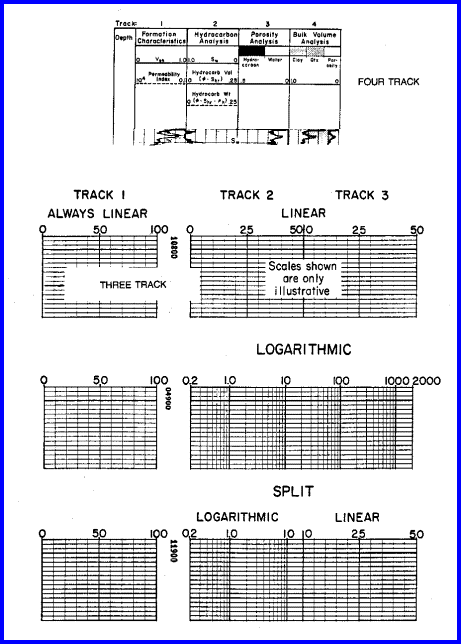
Various Log Grid Styles
The
space where the depth numbers are printed is called the depth
track and is often used for annotation of tops, DST and core data
by the analyst. Both right and left hand margins can also be used
for annotation.
Note
that logarithmic scales can also vary in presentation. The standard
scale is 4 decades wide starting at 0.2 and going to 2000. This
can be shifted one decade to give a 2 to 20000 scale or a partial
decade to give 0.1 to 1000 or 0.3 to 3000.
Linear
scales can be ANY RANGE. So check every time to find out what
scale is current on the section of log you are analyzing.
Back-up
scales are shown on the log heading underneath the primary scale.
Back-up scales take over when the primary curve goes off-scale.
Back-ups can be the same sensitivity (ie. 140 to 240 is the back-up
scale to 40 to 140) or a multiple of the primary scale (ie. 0
to 500 is the back-up to a 0 to 50 scale). Usually, but not always,
the multiple is 10 to 1 and the first one tenth of the back-up
scale is blanked out to prevent a confusion of curve. Logs exist
with back-ups with multiples of 5, 10, 100 and 1000 (all could
be on the same log) which gives a considerable range of answers
if the wrong scale is selected by the analyst.
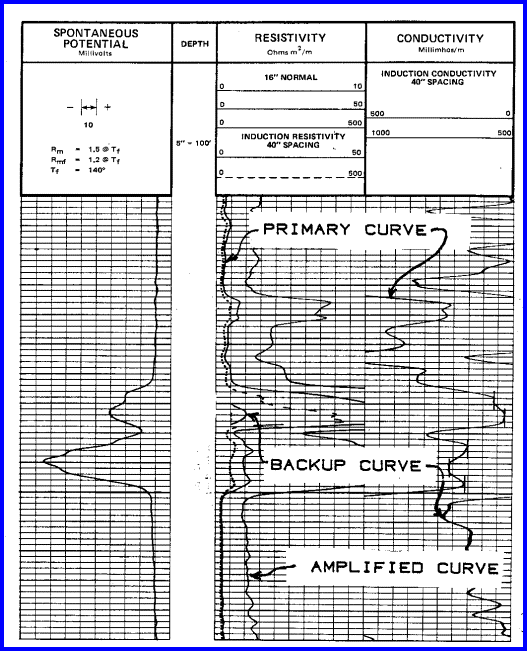
Primary, Backup, and Amplified Log Curves
The
use of logarithmic scales has reduced the need for back-up scales
on resistivity logs, but a back-up may also be seen to augment
a logarithmic scale. It will add another four decades to the scale
range. Back-ups are still common on other linear scales such as
the sonic, density, neutron and gamma-ray logs.
Amplified
scales are often presented on resistivity or sonic logs. For resistivity
logs the short normal curve can be shown amplified on a 0 to 2
or 0 to 4 scale, while the primary scale stays at 0 to 20 or 0
to 50 scale. The sonic log may show an amplified scale of 40 to
80 or 40 to 100 scale while the primary scale is 40 to 140. Amplified
scales are not used on logarithmic presentations, or on metric
sonic logs (scales of 100 to 300 or 100 to 500 usually give sufficient
detail with back-ups).
There are many variations in the presentation of well logs. There
are a few standard conventions, but local need often creates its
own conventions.
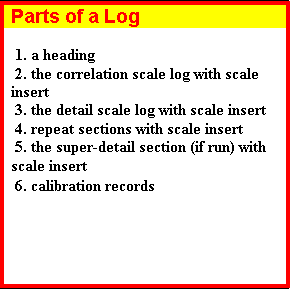 Usually
a log will be composed of several separate pieces spliced together
(splice can be physical, as separate pieces of film taped together,
or virtual as created by a computer playback): Usually
a log will be composed of several separate pieces spliced together
(splice can be physical, as separate pieces of film taped together,
or virtual as created by a computer playback):
Each
piece of log is recorded on film and the pieces are spliced together
in the order described above. A heading, with
basic well data, is spliced to the top of the correlation scale
film and a scale insert is spliced (usually) between each separate
piece of film. These inserts show the scale of each of the recorded
curves below the insert (and often above the insert as well).
On computerized logging units, the inserts may be an integral
part of the film.
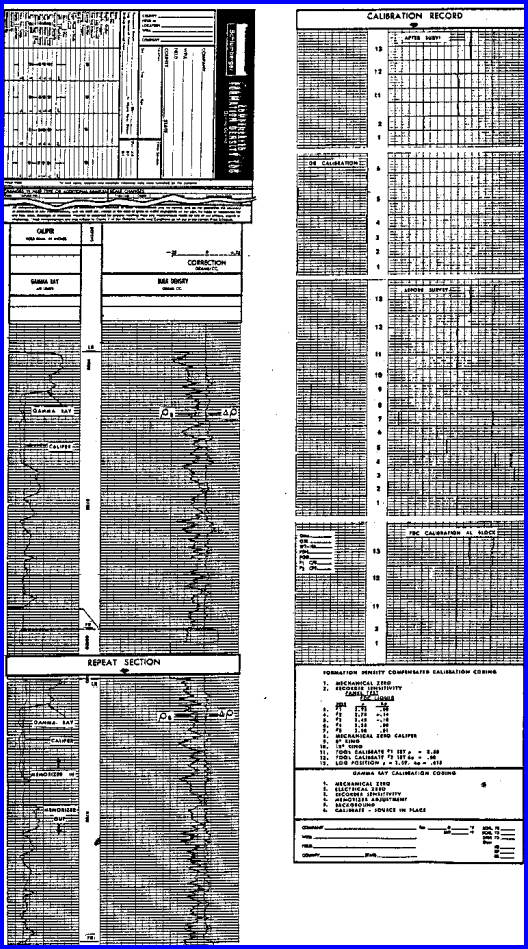
The Parts of a Log
|

